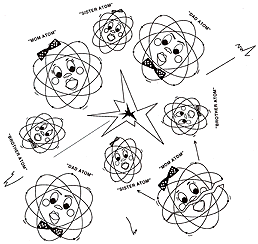 "Just like a beach is made of many grains of sand, everything in our world is made up of many very tiny pieces too small to be seen. We call these pieces ATOMS.
"Just like a beach is made of many grains of sand, everything in our world is made up of many very tiny pieces too small to be seen. We call these pieces ATOMS.
Atoms stay close, like a family. Most atoms are not breakable, but some atoms are. When they are split, the smaller atom pieces fly apart very fast. This is called ATOMIC or NUCLEAR ENERGY. Energy is the ability to do some kind of work. Color the Atoms Family!”
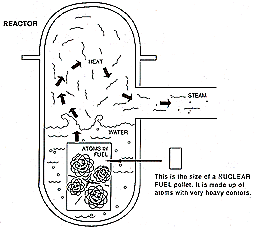 "The breakable atoms are split inside a big container called a NUCLEAR REACTOR. The nuclear reactor is a very important part of the NUCLEAR POWER PLANT, the place where ELECTRICITY is made -- just as your heart is important to your body.
"The breakable atoms are split inside a big container called a NUCLEAR REACTOR. The nuclear reactor is a very important part of the NUCLEAR POWER PLANT, the place where ELECTRICITY is made -- just as your heart is important to your body.
Many of these solid fuel pellets are put in a container inside the reactor. Here the tiny atoms in these pellets are split. Their pieces hit other atoms, and they are split, too. This energy action makes heat. The heat boils water, which turns into steam — just like in a tea kettle.”
 "Nuclear power plants, like this one, need water to make electricity.
"Nuclear power plants, like this one, need water to make electricity.
Which of the two paths will bring water to the nuclear power plant?”
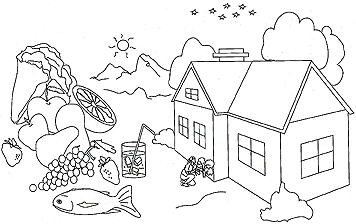 "Radiation also is all around us.
"Radiation also is all around us.
Most of the radiation in our world comes from natural things. Radiation comes from our food and water, the houses we live in, the air we breathe, our bodies, the sun, the earth, and outer space. All give off some radiation, just as the sun gives off heat and light. Color our world!”
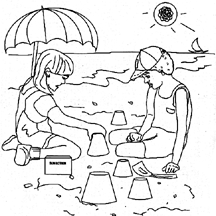 "The sun gives off one kind of radiation. It helps plants and trees grow. But too much radiation can hurt us. We need protection, called SHIELDING.
"The sun gives off one kind of radiation. It helps plants and trees grow. But too much radiation can hurt us. We need protection, called SHIELDING.
To protect ourselves from too much sunlight, we use sun lotion or wear clothes as shielding. See experiment 2 in back of this book.
Color this picture and describe which things are helping to shield the children from the sun’s radiation.”
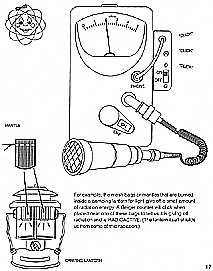 "Radiation can be measured using something called a GEIGER COUNTER.
"Radiation can be measured using something called a GEIGER COUNTER.
For example, the mesh bags or mantles that are burned inside a camping lantern for light give off a small amount of radiation energy. A Geiger counter will click when placed near one of these bags to tell us it is giving off radiation and is RADIOACTIVE. (The lantern itself shields us from some of this radiation.)”
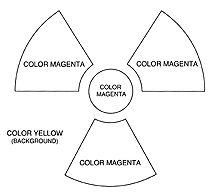 "This picture is a label put on many things and places where there is stronger radiation.
"This picture is a label put on many things and places where there is stronger radiation.
Color the picture as marked above.
This label is always colored MAGENTA, a shade of purple, on a yellow background. You should not touch or go into places marked with this label.”
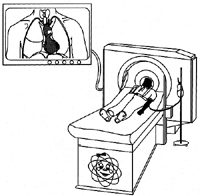 "Atoms that give off radiation energy are called RADIOISOTOPES. Radioisotopes can be used to do many things besides making electricity.
"Atoms that give off radiation energy are called RADIOISOTOPES. Radioisotopes can be used to do many things besides making electricity.
For example, sometimes radioisotopes in medicine are put into your body to treat an illness. They also can help take pictures of what’s happening inside your body. The radioisotope can be measured or TRACED as it goes through your body. See experiment 3 in back of this book.”
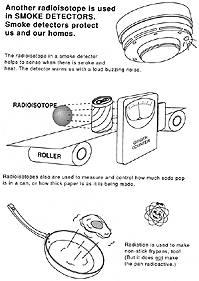 "Another radioisotope is used in SMOKE DETECTORS. Smoke detectors protect us and our homes.
"Another radioisotope is used in SMOKE DETECTORS. Smoke detectors protect us and our homes.
The radioisotope in a smoke detector helps to sense when there is smoke and heat. The detector warns us with a loud buzzing noise.
Radioisotopes also are used to measure and control how much soda pop is in a can, or how thick paper is as it is being made.
Radiation is used to make non-stick frypans, too! (But it does not make the pan radioactive.)”
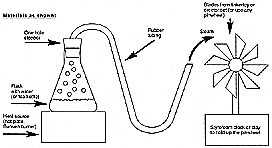 "Experiment 1 -- Make Your Own Model Turbine
"Experiment 1 -- Make Your Own Model Turbine
Make the model following this design.
What does this experiment remind you of? In this book we explained how we make electricity. Going from left to right, try to match the parts of this experiment to the parts of a nuclear power plant.
Be careful! Ask an adult for help! Keep your hands away from the steam. Steam is hot and it can burn you.”











